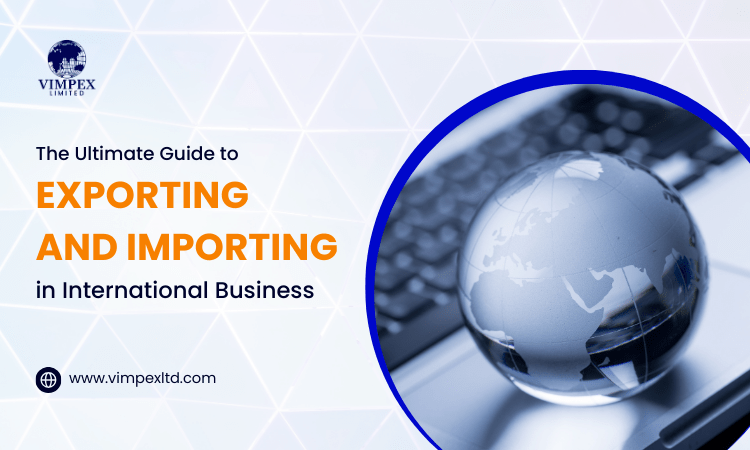Table of Contents
Introduction:
Here you can find all the information you need to know about international business exporting and importing. Import and export businesses in today’s globally interconnected world must be well-versed in the complexities of international trade. This all-inclusive book will provide you with the knowledge and skills to succeed in the export-import market, whether you’re a beginner or an established player seeking to grow your business. In order to become a master trader, you need to improve your knowledge of international import and export firms. Here you can find all the information you need to know about international business exporting and importing. Import and export businesses in today’s globally interconnected world must be well-versed in the complexities of international trade. This all-inclusive book will provide you with the knowledge and skills to succeed in the export-import market, whether you’re a beginner or an established player seeking to grow your business. In order to become a master trader, you need to improve your knowledge of international import and export firms.
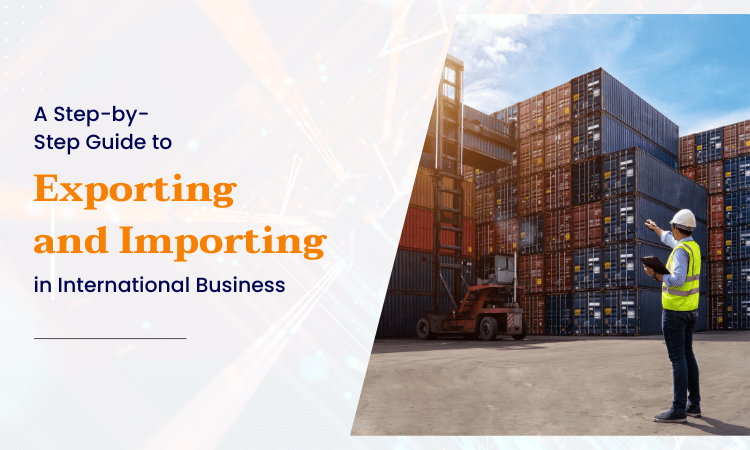
1. Navigating the Global Market: A Step-by-Step Guide to Exporting and Importing in International Business:
Today, by virtue of greater interdependence, one can discern even more opportunities of trade between nations. The growth of global trade has positively contributed to the expansion of business scope to millions of consumers spread across the world. Overseas import and export businesses which operate in the sectors of the oil industry could face both the opportunity of the lucrative status and the challenge of the status on the other hand. This part of the blog refers to the most vital issues that you need to consider and complete while you are acting in the global market.
Research and Analysis of the Market:
Before throwing their hats in the ring of a worldwide market, the companies engaged in import and export must be very keen on conducting meticulous market research. The range of procedures that is envisaged includes the identification of potential markets, the study of local regulations and estimations of product demand. Knowing the characteristics of specific markets and adjusting the strategy according to this may substantially increase the winning possibilities of the companies.
Keeping Records and Ensuring Compliance:
One has to go in for a stack of papers and a basket full of rules if importing and exporting stuff. Business needs to do some paperwork that consists of permits and certifications specific to every nation for its particular sector to set up shop. These principles might make a legal struggle for you to avoid and while staying in compliance, will help build the company’s credibility and trust toward the clients.
Managing Products and Their Supply Chains:
A multi-blank: The firm’s trade capacities are closely related to its supply management and logistics quality. From transporting to customs clearance, packaging and storage – all of these are the areas which companies should consider in order to control their delivery schedules and smooth operation of goods. An effective way to keep operations streamlined with minimum breaks is to have strong and established relations with third parties in their supply chain.
transactions involving the exchange of currency and payments:
Coordinating in international trade requires not only an understanding of various currencies but also dealing with exchange rates between currencies. The exigent experience of the foreign currency blocs, identifying risks in dealing with foreign exchange and selecting suitable methods of payments for transactions are extremely important. One of the ways to avoid fraud and make the collection process faster and more reliable is to develop an effective payment administration mechanism.
2. Uncharted Waters: Essential Considerations for Thriving in International Trade:
The market glamour excites many businesses, giving substantive customers with broad access. Though also promising fabulous growth, in some cases, few of these companies could survive. While it seems like international trade waters are relatively simple, it is actually filled overflow with reefs that you can not see and unpredictable currents. Those who dare set sail require the prudence of planning and in-depth knowledge of the ocean in order to achieve success.
This blog delves into the essential considerations for successfully exporting and importing in international business:
1. Know Your Currents:
It is absolutely critical to study trade regulations, culture, and trends for each country in order to approach your destination countries. With knowledge of those tides, you’ll be able to write and plan your portions accordingly and save yourself from wasting lots of resources.
2. Chart Your Course:
Form a fully-fledged export/import tact that suits your products’ characteristics, your objectives, and your resources upon the target markets. The plan gives you the way to walk, which you can use to make decisions and not to diverge from the route.
3. Assemble Your Crew:
Working with reliable logistics providers, legal experts, and cultural consultants will allow you to expand your expertise and overcome issues, you also might use it to use opportunities.
4. Weather the Storms:
A trade sign that contains both advantages and disadvantages is implicit such as unforeseen bars caused by currency fluctuations or trade fears. By establishing your systems to be resilient and adaptable, you will be ready to overcome any kind of hurdle.
5. Embrace the Voyage:
The global trade is indeed a process and not the endpoint. Continuous training, innovations, and cultural sensitivity are not only the key but above all will contribute to the long-term success of the organization.
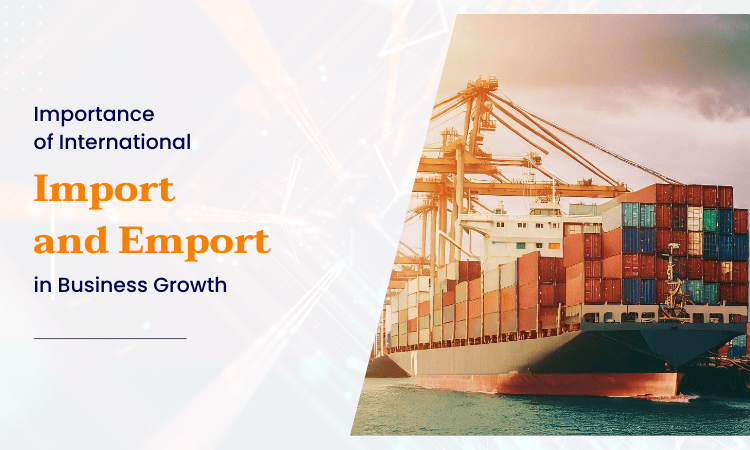
3. Understanding the Importance of International Import and Export in Business Growth:
The opportunities of today’s business development become doable not even inside country borders. Countries become less isolationist through export and import of international trade which open all sorts of market doors, various sources of income, and numerous opportunities. Even though it is at the beginning a surprising fact, realizing the importance of international trade can definitely change the perspective on how to shape the business strategy.
1. Reaching New Audiences:
Think about it. There is an audience that is, statistically, off-the-charts surrounding you. The fact that you export enables you to expand your horizons and reach new consumers with different interests, preferences, and cultures, hence, you create a wide range of markets that reduces your dependence on any arising market. Cultures being unique, the comprehension of cultural nuances and fitting your offerings to meet these specificities will boost your business growth abroad.
2. Sourcing Superior Goods and Services:
The scope and depth of the resources and expertise available to the domestic economy expands when it imports. You can buy cheap raw materials, components or finished goods but at the same time to ensure sustainability of quality and can optimize your production process and give adventage for you. Further, complementing your business with international partners brings knowledge and know-how that strengthens the innovation and rise of a business.
3. Enhanced Competitiveness:
Involving yourself in international trade naturally requires the expansion of your horizon and the embracement of new things. The world marketplace requires companies to meet quality customers’ expectations, thrive in the competitive environment, and be efficient in their operations. You do not only obtain clientele because you are market leader; rather, by complying to these standards, you improve the performance of your business, transforming it into a more efficient, competitive, and adaptable one, even within the domestic market.
4. Economic Contribution:
When you import and export, you actually have a role that is much bigger than what was assigned to you. You are doing your own business as well as helping the development of the world economy. Through the promotion of trade flows, you spur job creation, provide support to economic welfare, and encourage cultural exchanges. The global economic environment will be much stronger because of this both on your international side and a more interconnected and happy society in the world.
4. The Dos and Don'ts of Exporting and Importing in the International Market:
The international market calls you to action with the promise of exciting opportunities but finding your way through the maze of complexities might scare you up just like you would be on boarding an un-charted ship.Fear not, intrepid entrepreneur! When knowing the principal “must-dos” and “must-nots” you will be able to lay a stable foundation for steady and prosperous exports and imports of your business.
Do’s:
- Research, research, research! Therefore, be extremely acquainted with the regulations, cultural factors and market trends of the countries that you are targeting. Knowledge is not only your experience as a guide but also your lifebuoy when you are overwhelmed in uncharted territories.
- Partner with experts. Get to know your logisticists, lawyers, and culture consultants, when you have to deal with a wide range of very complicated things and they can help you reduce the risk of problems.
- Adapt your approach. Don’ t be rigid, expect a kind of strategy that fits all. Focus on your particular value proposition, and tailor your message and your marketing communication to each target market’s special needs and taste.
- Prioritize compliance. Make sure to have everything in order including permits and other documents to avoid fines and a delay in the process. Compliance function as your lifejackets – together with them you can be sure that the constant change of regulations do not swamp you.
- Build strong relationships. Entrust and maintain smooth communication with your international partners, suppliers, and customers. Unbreakable connections are like wind in your sails, which move your boat, pushing you in the right direction.
Don’ts:
- Rush into things. Know your time and in turn craft a clearly-defined strategy for export/import that is in tune with your business objectives and available resources. Trouble decisions might as well be the same as dealing with a coral reef because it is the reef who takes the main blow.
- Ignore cultural differences. Many processes and relations, including in politics, boil down to cultural sensitivity that leads to understanding and avoidance of mistakes. Don’t imprudently hold all the cards – mind the etiquette and the way of doing business in the country of destination.
- Underestimate logistics. Add to your consideration go-bets, custom clearance, and delay possible. Unplanned logistical problems can be akin to big waves that are unexpectedly stirring and make your plan only invisible.
- Neglect communication. To remain in constant interaction with such partners, suppliers and customers while the process is running, relates to the second step. Transparent communication is your elevator that guides you in maintaining right path and the desired method of implementation.
- Overlook risks. Pay attention to risks such as currency fluctuations, trade wars or political instability, that could suppress business operations and decrease profit. Proactive risk management, similar to strong hull on a ship, protects us from the massive waves in a seamless manner.

5. Mastering the Art of International Trade: Tips for Successful Export and Import Operations:
The allure of expanding beyond your domestic market is undeniable, but successfully navigating the intricate world of international trade requires more than just packing your bags and hoping for the best. Fear not, aspiring global merchant! By mastering the art of import and export operations, you can unlock a wealth of opportunities for growth and diversification. Here are some key tips to guide you on your journey:
1. Knowledge is Power:
Before taking the plunge, immerse yourself in the intricacies of your target market. Research legal regulations, cultural nuances, and trade agreements. Consider partnering with international trade specialists for in-depth guidance. Remember, knowledge is your compass, ensuring you navigate unfamiliar waters with confidence.
2. Build Trustworthy Partnerships:
Don’t go it alone. Partner with reliable logistics providers, legal experts, and cultural consultants. These partnerships are like sturdy masts, providing essential support and expertise to keep your ship afloat.
3. Adaptability is Key:
Don’t assume a one-size-fits-all approach. Tailor your offerings and communication to resonate with your target market’s unique needs and preferences. Cultural sensitivity is crucial for building trust and avoiding misunderstandings. Remember, adaptability is the wind in your sails, propelling you towards success.
4. Stay Compliant, Stay Afloat:
Ensure all documentation and permits are in order to avoid costly delays and penalties. Treat compliance as your life raft – it keeps you afloat amidst ever-changing regulations.
5. Embrace Technology:
Leverage technology to streamline operations, facilitate communication, and optimize logistics. Digital tools can be your anchor, simplifying complex processes and ensuring smooth sailing.
6. Network, Network, Network:
Building strong relationships with international partners, suppliers, and customers is vital. Attend trade shows, participate in online forums, and actively engage with your network. These connections are like a strong hull, protecting you from unexpected challenges.
7. Continuous Learning is Key:
The world of international trade is constantly evolving. Stay updated on market trends, regulations, and cultural shifts. Continuous learning is like upgrading your sails, ensuring you can navigate even the most unpredictable winds.
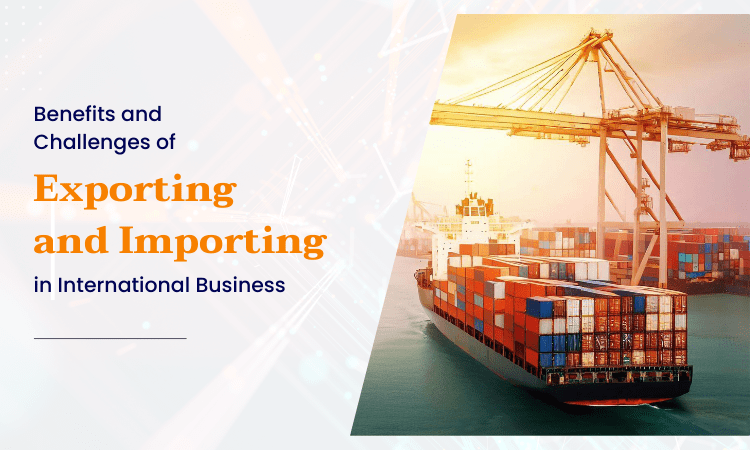
6. Exploring the Benefits and Challenges of Exporting and Importing in International Business:
For many businesses, the allure of the international market is undeniable. The potential for increased revenue, diversified customer bases, and access to unique resources is a powerful motivator. Yet, venturing into the waters of international trade also presents its own set of challenges. Let’s explore both sides of the coin, equipping you to make informed decisions about your business’s future.
Sailing towards the Benefits:
- Expanded Market Reach: Access a vast customer base beyond your domestic borders, increasing sales potential and mitigating dependence on any single market.
- Diversified Revenue Streams: Reduce reliance on any one customer or industry, spreading your risk and providing financial stability.
- Enhanced Competitiveness: Exposure to international competition drives innovation, efficiency, and quality improvement, making you a stronger player in any market.
- Access to Unique Resources: Source raw materials, components, or finished goods at competitive prices and higher quality, potentially optimizing your production process.
- Economic Contribution: Facilitate trade flows, create jobs, promote economic development, and contribute to a more interconnected and prosperous world.
Navigating the Challenges:
- Increased Complexity: Complexities arise from diverse regulations, cultural differences, logistics, and potential language barriers. Careful planning and expert guidance are crucial.
- Intense Competition: Facing established international players who may have greater resources and experience requires a well-defined competitive advantage.
- Financial Risks: Fluctuating exchange rates, delayed payments, and unforeseen logistical issues can impact profitability. Careful risk management is essential.
- Cultural Nuances: Adapting your offerings and communication to resonate with diverse cultures is crucial for building trust and avoiding misunderstandings. Cultural sensitivity is your anchor.
- Legal and Regulatory Hurdles: Understanding and complying with international trade regulations, tariffs, and documentation requirements can be a complex task.
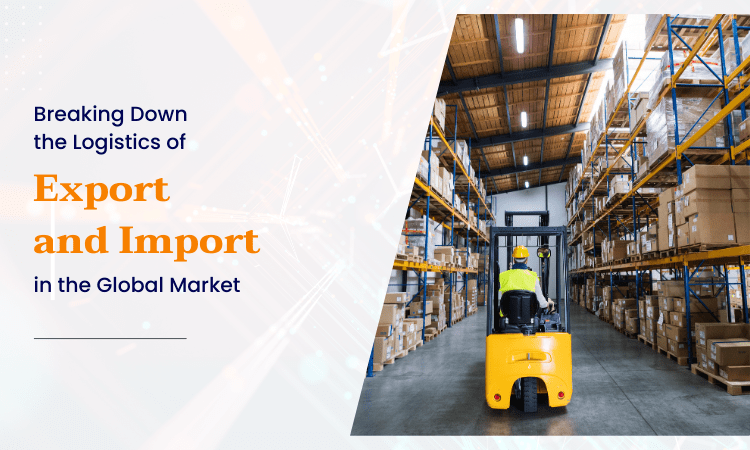
7. Breaking Down the Logistics of Export and Import in the Global Market:
For many businesses, the global market beckons with its promise of diverse customers and exciting opportunities. But venturing into international trade can feel like entering a labyrinth, filled with unfamiliar routes, hidden obstacles, and complex procedures. Fear not, intrepid entrepreneur! By breaking down the essential logistics of exporting and importing, you can chart a clear course and navigate the labyrinth with confidence.
Exporting:
- Packing and Labeling: Ensure your goods meet international packaging and labeling standards to avoid delays and fines. Partner with logistics providers familiar with your target market’s requirements.
- Transportation: Choose your mode of transport (air, sea, land) based on cost, speed, and cargo type. Utilize reliable freight forwarders for seamless transport and customs clearance.
- Documentation: Prepare export declarations, commercial invoices, certificates of origin, and other necessary documents. Accuracy and completeness are crucial to avoid delays and penalties.
- Customs Clearance: Understand and comply with the customs regulations of your target country. Partner with customs brokers to ensure smooth clearance and minimize hassle.
Importing:
- Sourcing: Identify reliable suppliers who meet your quality, cost, and ethical standards. Research potential trade partners carefully, considering certifications and reputation.
- Financing: Understand different payment methods (letters of credit, open accounts) and their associated risks. Secure trade finance options if needed.
- Import Duties and Taxes: Be aware of applicable import duties, taxes, and regulations. Factor these costs into your pricing strategy.
- Distribution and Warehousing: Decide on your distribution strategy (direct sales, local partners) and consider warehousing options in your target market for efficient delivery.
Navigating the Maze:
- Partner with experts: Collaborate with freight forwarders, customs brokers, legal advisors, and cultural consultants to navigate the complexities of international trade.
- Technology is your friend: Utilize logistics management software and online platforms to streamline processes and track shipments in real-time.
- Communication is key: Maintain clear and consistent communication with suppliers, partners, and customers throughout the process.
- Stay informed: Keep up-to-date on changing regulations, market trends, and cultural nuances to adapt your strategy accordingly.
8. Essential Tools and Resources for Streamlining Your Export and Import Processes in International Business:
The thrill of expanding your business into the global market can quickly turn into administrative chaos without the right tools and resources. Navigating complex documentation, regulations, and logistics across borders can feel like wrestling a paper dragon. Fear not, intrepid trader! By leveraging the right tools and resources, you can streamline your export and import processes, tame the dragon, and claim your international trade victory.
Tools for Efficiency:
- Freight Forwarding Software: Platforms like Flexport or ShipStation manage shipments, track goods, handle customs paperwork, and provide real-time visibility.
- Export Documentation Software: Solutions like Export Doc Worldwide or Tradewin simplify export declaration creation, ensuring compliance and reducing errors.
- Translation Tools: Google Translate or DeepL offer fast, basic translations. For critical documents, consider professional translation services.
- International Payment Solutions: Platforms like Payoneer or Wise facilitate secure and efficient cross-border transactions with competitive exchange rates.
- Market Research Tools: Utilize platforms like Euromonitor or GlobalData to research market trends, competitor analysis, and consumer insights for your target markets.
Resources for Guidance:
- Government Agencies: The International Trade Administration (ITA) in the US or similar export promotion agencies offer resources, guides, and support programs for exporters.
- Industry Associations: Join industry-specific associations for targeted resources, networking opportunities, and industry expertise.
- Export Credit Agencies: Government-backed agencies like the Export-Import Bank of the United States (EXIM) offer export financing and risk mitigation solutions.
- Logistics & Trade Compliance Consultants: Partner with experts to navigate complex regulations, customs clearance, and logistical challenges.
- Online Trade Communities: Online forums and communities like World Trade Organization’s Trade Talks connect you with other traders for peer-to-peer advice and information sharing.

9. Strategies and Success Stories of Prominent Export and Import Companies:
In the ever-evolving landscape of international business, the success stories of prominent export and import companies stand as a testament to strategic prowess and adaptability. Navigating the complexities of exporting and importing in international business, these industry leaders have not only overcome challenges but have also carved a path for others to follow.
International import and export companies form the backbone of global trade, and understanding their strategies is crucial for aspiring businesses. These companies have mastered the art of export-import international trade, seamlessly connecting markets and driving economic growth. Their success stories offer invaluable insights into the intricacies of building a robust presence in the international arena.
One key strategy employed by these industry leaders is a thorough understanding of the export-import landscape. From compliance with international regulations to leveraging trade agreements, these companies have honed their expertise to navigate the intricate web of global trade seamlessly.
The adoption of advanced technologies is another common thread among successful export and import companies. Embracing digital platforms for streamlined logistics, data analytics for market insights, and innovative solutions for supply chain management, these companies stay at the forefront of technological advancements to enhance efficiency and reduce costs.
10. Key Considerations for Finding and Partnering with Reliable International Import and Export Services:
In the realm of exporting and importing in international business, the choice of a reliable partner can make all the difference. As businesses seek to expand their global footprint, collaborating with trustworthy international import and export companies becomes paramount. This article explores key considerations to guide enterprises in finding and forging partnerships with dependable service providers in the dynamic world of international trade.
When venturing into the global market, businesses must prioritize due diligence in selecting international import and export services. Exporting and importing in international business, underscores the critical role these services play in facilitating seamless cross-border transactions. Look for companies that demonstrate a comprehensive understanding of international trade regulations, ensuring compliance and mitigating potential risks.
Evaluate the track record of potential partners, considering their experience in navigating complex customs procedures, documentation, and adherence to global standards.
Furthermore, businesses should assess the technological capabilities of prospective partners. Advanced digital platforms, data analytics, and real-time tracking systems are indicative of a company’s commitment to efficiency and transparency in international operations.
Conclusion:
Navigating the world of international import and export can be a complex journey. However, armed with the knowledge gathered from our ultimate guide, exporting and importing in international business should be a smoother process. By understanding the nuances of trade, exploring the services of international import and export companies, and keeping up with international trade regulations, businesses can thrive in the global market.

